The canine arthritis treatment market is experiencing robust growth. Rising awareness of pet health, increasing cases of osteoarthritis in aging dogs, and growing expenditure on veterinary care are driving market expansion. The market is being supported by improved diagnostic capabilities, the availability of advanced therapeutics, and the growing acceptance of preventive healthcare practices among pet owners.
Pharmaceutical innovation focusing on safety, efficacy, and long-term management has enhanced treatment outcomes and compliance. Demand is further supported by the increasing humanization of pets and the resulting prioritization of animal well-being. The future outlook remains positive as veterinary infrastructure strengthens, and new product pipelines introduce targeted therapies with fewer side effects.
Regulatory approvals for novel drug formulations and expanding distribution networks are also contributing to accessibility Collectively, these developments are expected to sustain steady market growth, strengthen brand positioning among key manufacturers, and support continued expansion of treatment adoption across global veterinary care settings.
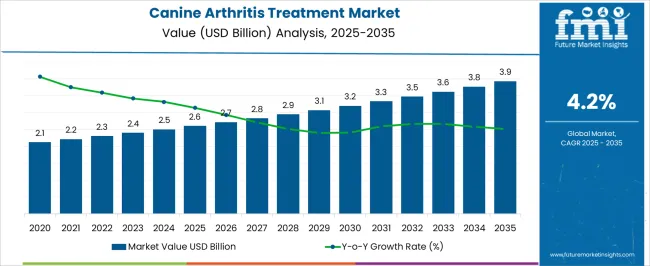
| Metric | Value |
|---|---|
| Canine Arthritis Treatment Market Estimated Value in (2025 E) | USD 2.6 billion |
| Canine Arthritis Treatment Market Forecast Value in (2035 F) | USD 3.9 billion |
| Forecast CAGR (2025 to 2035) | 4.2% |
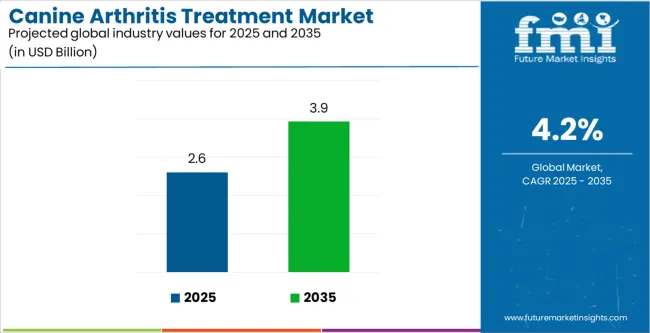
The market is segmented by Treatment, Route Of Administration, and Distribution Channel and region. By Treatment, the market is divided into Non-Steroidal Anti-Inflammatory Drugs (NSAIDs), Opioids, Stem Cell Therapy, Allogeneic Stem Cells, and Autologous Stem Cells. In terms of Route Of Administration, the market is classified into Oral Canine Arthritis Treatment and Injectable Canine Arthritis Treatment. Based on Distribution Channel, the market is segmented into Veterinary Hospitals & Clinics, Retail Pharmacies, Drug Stores, and E-Commerce. Regionally, the market is classified into North America, Latin America, Western Europe, Eastern Europe, Balkan & Baltic Countries, Russia & Belarus, Central Asia, East Asia, South Asia & Pacific, and the Middle East & Africa.
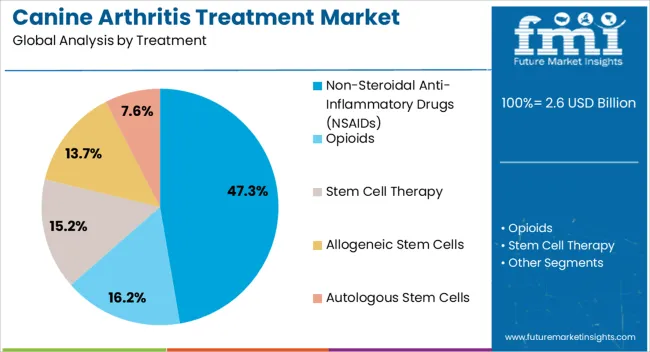
The non-steroidal anti-inflammatory drugs (NSAIDs) segment, accounting for 47.30% of the treatment category, has been leading due to its proven efficacy in pain relief and inflammation control. Its dominance is supported by broad clinical acceptance and consistent results in improving mobility and quality of life in arthritic dogs. Ease of administration and rapid onset of action have made NSAIDs a preferred first-line therapy among veterinarians.
Market share is being reinforced by ongoing research aimed at improving gastrointestinal and renal safety profiles. Manufacturers are focusing on extended-release formulations and combination therapies to enhance convenience and therapeutic outcomes.
Regulatory bodies have supported this segment through approvals of safer and more targeted NSAID variants As clinical adoption grows and awareness of early intervention increases, the NSAIDs category is expected to retain its leadership position, contributing significantly to revenue generation in the canine arthritis treatment market.
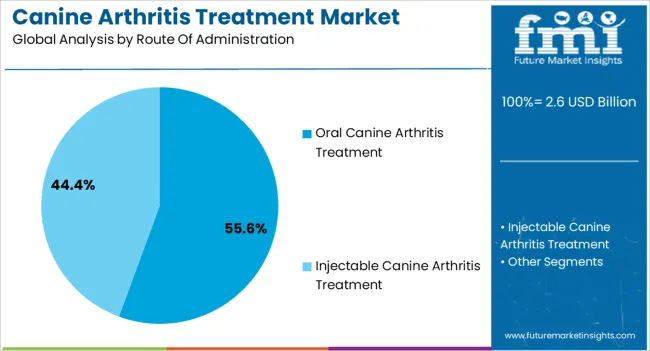
The oral canine arthritis treatment segment, representing 55.60% of the route of administration category, remains the dominant method due to its convenience, cost-effectiveness, and ease of use for pet owners. Widespread availability of oral tablets, chewables, and flavored formulations has improved compliance among both veterinarians and pet owners.
The segment’s performance is reinforced by consistent dosing accuracy and established efficacy across a wide range of NSAIDs and supplementary therapies. Demand is being sustained by increasing product innovation focused on palatable and long-acting oral formulations.
Veterinary recommendations favoring oral administration for long-term management are further enhancing market penetration With continuous advancements in pharmacokinetics and controlled-release technologies, oral treatments are expected to maintain their leading share, driving consistent growth throughout the forecast period.
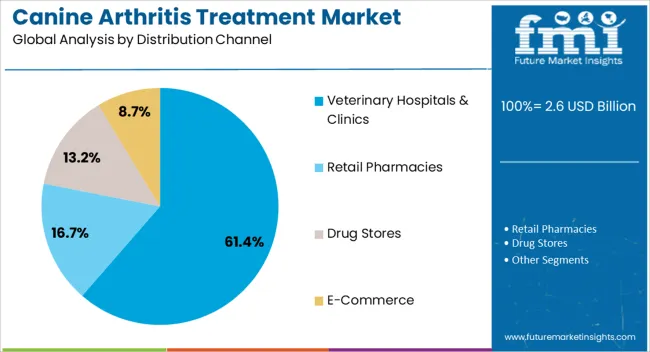
The veterinary hospitals and clinics segment, holding 61.40% of the distribution channel category, dominates due to its established role in providing professional diagnosis, prescription, and follow-up care. Centralized procurement systems and trusted veterinary expertise have enhanced product reliability and accessibility.
Pet owners increasingly rely on veterinary clinics for both diagnosis and medication sourcing, strengthening this channel’s influence. The segment benefits from integrated treatment support, direct consultations, and personalized therapy plans, which reinforce adherence and therapeutic outcomes.
Market growth is further supported by the global expansion of veterinary chains, increased investment in animal healthcare infrastructure, and ongoing training of veterinary professionals As awareness of chronic disease management in pets rises, veterinary hospitals and clinics are expected to remain the primary distribution hub, ensuring consistent product availability and long-term dominance within the market.
The canine arthritis treatment industry generated a valuation of USD 2.1 billion in 2020. The market grew at a rate of 5.0% CAGR over five years, generating an additional USD 2.6 million in valuation by 2025.
This growth can be attributed to various factors:
The canine arthritis treatment market is anticipated to grow at a modest CAGR of 4.20% till 2035. This is attributed to several reasons:
The NSAIDs category is projected to hold the largest share of the canine arthritis treatment market in the year 2025. This segment holds the dominant market share, accounting for 72% of the global canine arthritis treatment market.
| Attributes | Details |
|---|---|
| Drug Class | NSAIDs |
| Market Share | 72.00% |
The canine arthritis treatment market is also categorized by route of administration into oral and injectable canine arthritis treatment. The oral segment dominates the market with a share of 70% in 2025.
| Attributes | Details |
|---|---|
| Route of Administration | Oral |
| Market Share | 70.00% |
The section provides an analysis of the canine arthritis treatment market by country, including India, Spain, Italy, Australia, and France. The table presents the CAGR for each country, indicating the expected growth of the market in that country through 2035.
| Countries | CAGR |
|---|---|
| Spain | 5.50% |
| India | 5.30% |
| Italy | 4.90% |
| Australia | 4.70% |
| France | 4.60% |
India is expected to exhibit significant market growth over the forecast period. The Indian market for canine arthritis treatments is anticipated to grow at a CAGR of 5.30% through 2035.
Spain is also one of the lucrative markets in the canine arthritis treatment industry. The Spanish market for canine arthritis treatments is anticipated to grow at a CAGR of 5.50% through 2035.
Italy also is a promising market in the global canine arthritis treatment industry. Over the next ten years, the Italian demand for canine arthritis treatments is projected to rise at a 4.90% CAGR.
Australia is also one of the countries that is filled with potential in this market. The Australian canine arthritis treatment market is anticipated to retain its dominance by progressing at a growth rate of 4.70% till 2035.
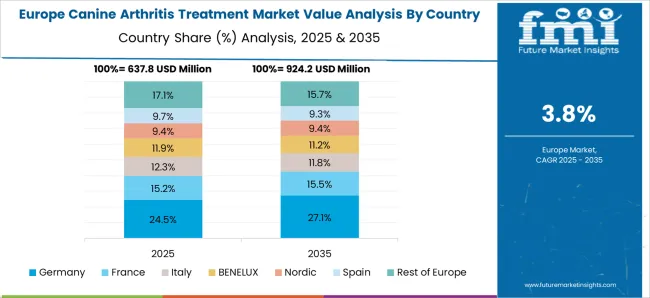
France also exhibits a promising future in the global canine arthritis treatment market. The canine arthritis treatment market in France is anticipated to retain its dominance by progressing at a growth rate of 4.60% till 2035.
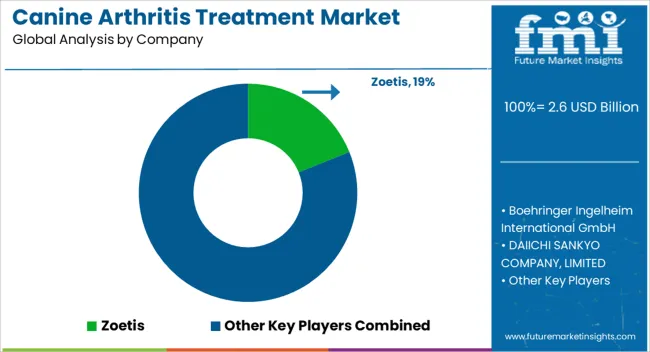
Major companies and manufacturers in the canine arthritis treatment market, such as Boehringer Ingelheim International GmbH., DAIICHI SANKYO COMPANY, LIMITED, Thorne, NUTRI-VET, American Regent, Inc., DSM, etc., investing heavily in research and development to innovate new medications, supplements, and therapeutic approaches.
These companies are also expanding their distribution networks and partnerships with veterinary clinics, pet retailers, and online platforms to enhance the market reach and accessibility of their products to pet owners.
Recent Developments:
The global canine arthritis treatment market is estimated to be valued at USD 2.6 billion in 2025.
The market size for the canine arthritis treatment market is projected to reach USD 3.9 billion by 2035.
The canine arthritis treatment market is expected to grow at a 4.2% CAGR between 2025 and 2035.
The key product types in canine arthritis treatment market are non-steroidal anti-inflammatory drugs (nsaids), opioids, stem cell therapy, allogeneic stem cells and autologous stem cells.
In terms of route of administration, oral canine arthritis treatment segment to command 55.6% share in the canine arthritis treatment market in 2025.






Full Research Suite comprises of:
Market outlook & trends analysis
Interviews & case studies
Strategic recommendations
Vendor profiles & capabilities analysis
5-year forecasts
8 regions and 60+ country-level data splits
Market segment data splits
12 months of continuous data updates
DELIVERED AS:
PDF EXCEL ONLINE
Canine Orthopedic Implants Market Size and Share Forecast Outlook 2025 to 2035
Canine Dilated Cardiomyopathy Drugs Market – Trends & Forecast 2025 to 2035
The Canine Flu Therapeutics Market is segmented by product, and end user from 2025 to 2035
Global Canine Cancer Screening Market Analysis – Size, Share & Forecast 2024-2034
Canine Weight Loss Drugs Market
Canine Atopic Dermatitis Treatment Market Growth – Demand & Forecast 2024-2034
Osteoarthritis Gene Therapy Market
Reactive Arthritis Treatment Market Size and Share Forecast Outlook 2025 to 2035
Psoriatic Arthritis (PsA) Treatment Market Insights – Growth & Forecast 2024-2034
Rheumatoid Arthritis Therapeutics Market Size and Share Forecast Outlook 2025 to 2035
Rheumatoid Arthritis Treatment Market
Axial Spondyloarthritis Management Market Analysis by Types, End-User, Drug Class, and Region through 2035
Juvenile Idiopathic Arthritis Diagnostic Market Trends – Demand & Future Outlook 2024-2034
Treatment-Resistant Hypertension Management Market Size and Share Forecast Outlook 2025 to 2035
Treatment-Resistant Depression Treatment Market Size and Share Forecast Outlook 2025 to 2035
Treatment Pumps Market Insights Growth & Demand Forecast 2025 to 2035
Pretreatment Coatings Market Size and Share Forecast Outlook 2025 to 2035
Air Treatment Ozone Generator Market Size and Share Forecast Outlook 2025 to 2035
CNS Treatment and Therapy Market Insights - Trends & Growth Forecast 2025 to 2035
Seed Treatment Materials Market Size and Share Forecast Outlook 2025 to 2035

Thank you!
You will receive an email from our Business Development Manager. Please be sure to check your SPAM/JUNK folder too.
Chat With
MaRIA